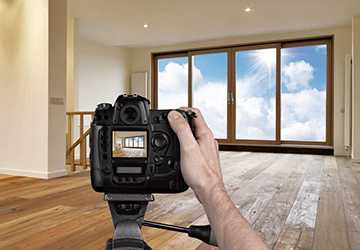Real estate photography is a critical element in showcasing properties effectively. Great photos can significantly enhance the appeal of a listing, attracting more potential buyers and increasing the sale value. Here are seven tips to master the art of real estate photography.

Understand the Property’s Unique Features
Before snapping photos, take time to understand what makes the property special. Is it the spacious backyard, the modern kitchen, or the panoramic views? Identifying these key features helps you focus your photography efforts on areas that impress potential buyers.
Use the Right Equipment
Investing in the right equipment can dramatically improve the quality of your real estate photography. A DSLR camera with a wide-angle lens is ideal for capturing spacious interiors and expansive exteriors. Additionally, consider using a tripod for stability, especially in low-light conditions.
Maximize Natural Light
Natural light can make spaces appear larger, brighter, and more inviting. Schedule your photoshoot during the day when sunlight is abundant. Open curtains and blinds to let in as much light as possible. However, be mindful of glare and shadows that might detract from the photo's quality.
Pay Attention to Composition
Good composition is critical in photographing properties. Use the rule of thirds to create balanced and interesting shots. Highlight the depth and scale of rooms by including foreground, middle ground, and background elements. This technique helps potential buyers better understand the layout of the property.
Stage the Property
Staging is all about presenting the property in its best light. Remove clutter, arrange furniture neatly, and add some decorative touches to make the space more appealing. Remember, you’re not just selling a house; you’re selling the idea of a home.
Enhance with Post-Processing
Even the best shots can benefit from tweaking. Use post-processing software to adjust brightness, contrast, and saturation to make your photos pop. However, it's crucial to keep edits realistic. Overly processed images can be misleading and may turn off potential buyers.
Offer a Virtual Tour
In the digital age, offering a virtual tour can significantly enhance your real estate photography portfolio. Virtual tours allow potential buyers to explore the property at their own pace, providing a comprehensive view that still photos alone can't achieve.
Capturing the Exterior
● The exterior is often the first thing potential buyers see. Ensure the property's outside is clean and well-maintained.
● Experiment with different angles to find the most flattering view of the property.
● Shooting during the golden hour, just after sunrise or before sunset, can result in beautifully lit photos with a warm glow.
Photographing the Interior
● A tidy space is crucial for good interior shots. Ensure each room is clean and free from unnecessary clutter.
● Focus on Key Areas: Prioritize areas like the living room, kitchen, and main bedroom. These are often the most important to potential buyers.
● Use Appropriate Lighting: If natural light is insufficient, use soft artificial lighting to brighten the space.
Post-Processing Tips
● Keep It Real: Avoid over-editing. Photos should enhance the property's appeal without misleading viewers.
● Correct Distortions: Wide-angle lenses can sometimes distort images. Use editing software to correct these distortions.
● Balance the Colors: Ensure the colours in your photos accurately represent the property. Adjust the white balance if necessary.

Additional Tips
Embrace Different Weather Conditions
Don't be discouraged by less-than-perfect weather. Overcast skies can minimize harsh shadows and reduce the chances of overexposure, while rain can add a unique, reflective quality to surfaces, making them look more vibrant. Use these conditions to your advantage to capture unique and evocative images of the property.
Understand the Importance of Color Psychology
Colours play a crucial role in setting the mood of a photograph. Warm tones like reds and oranges can evoke a sense of cosiness, while cool tones like blues and greens are calming and serene. When editing your photos, consider the psychological impact of the colours and adjust them to convey the right emotion for each space.
Use Leading Lines for Stronger Compositions
Leading lines guide the viewer's eye through the photograph and can make real estate photos more dynamic. Look for natural lines in the property’s design - such as pathways, fences, or architectural features - and use them to lead towards the main subject of your photo.
Experiment with Different Times of Day
Shooting at different times can drastically change the mood and feel of your real estate photography. Early morning and late afternoon provide soft, golden light, while midday light can be harsh but can vividly showcase the property’s details.
Highlight Unique Architectural Details
If the property has unique architectural features like vaulted ceilings, original hardwood floors, or custom-made cabinetry, highlight these in your photos. These details can be a significant selling point and should be prominently featured.
Incorporate Lifestyle Elements
Adding a human element can make a property feel more livable and appealing. Consider staging a scene where a person interacts with the space naturally, like reading a book in a cosy nook or enjoying a meal in the dining area; this helps potential buyers envision themselves in the home.
Offer Different Perspectives
Don’t just limit yourself to standard shots. Experiment with high-angle shots to give an overview of a room or low-angle shots to emphasize space. This variety can give potential buyers a better understanding of the property.
Stay Updated with Trends
Real estate and photography trends evolve. Keep up with the latest interior design and photography trends to ensure your photos meet current standards and appeal to modern buyers.
Conclusion
In conclusion, compelling real estate photography requires a mix of technical skill, creativity, and an understanding of what buyers are looking for. By following these tips on photographing properties and improving property photos, you can create compelling, attractive images that help properties sell faster and potentially at better prices. Remember, in real estate, a picture is not just worth a thousand words—it's worth potentially thousands of dollars.


